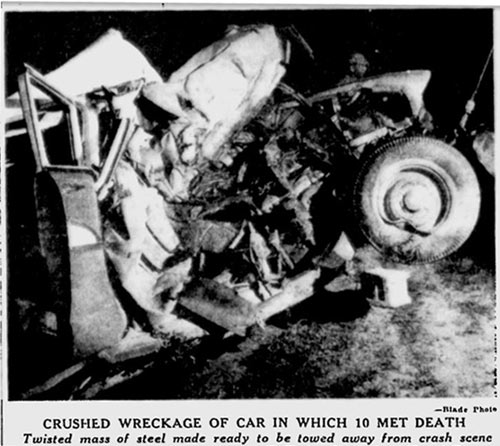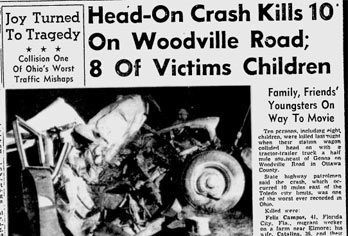It’s not something today’s drivers think about all that much, but in terms of safety, cars have come a long way in fifty years from the deathtraps they used to be.
Even so, coming across the story about the ten people killed in a traffic accident on July 31, 1963 was still a shock.
Feliz Campos, a 41-year-old Florida migrant worker, was driving westbound on Woodville Road with his wife, their five children, and three children from another family. According to the State Highway Patrol, Campos attempted to pass when he struck an A&P truck head-on about a half-mile southeast of Genoa at 8:55 p.m. The ten, all wedged into a 1957 Chevrolet station wagon, were going to a drive-in theater.
“All victims suffered multiple fractures,” the story flatly stated. “Some were thrown out of their vehicle.” The truck driver suffered minor injuries.

The ten were all members of migrant worker families, coming to work in Northwestern Ohio to pick vegetables in the field. It is an phenomenon I thought had mostly passed in Northwestern Ohio, but a quick glance around showed this is not the case at all. Ohio still has 14,000 migrant workers yearly according to this Blade story from 2012.
Classic cars are great, and I love them, but the hazards of driving them are pretty obvious: metal dashes, the lack of shoulder and lap seat belts, to name but a few.
The Ohio State Highway Patrol made a graphic film, Signal 30, in 1959, and you can watch it here if you’re into that sort of thing. Its point was to probably scare new drivers into being careful, and make them aware of the consequences of their actions. To the modern day viewer, however, it gives some sense of the frail safety cars in the late 50s and early 60s provided. Cars were routinely destroyed in accidents and offered little or no protection to the occupants.
Today that’s all changed.
The auto industry, basically under the direction of the government through such agencies as the National Highway Traffic Safety Administration, eventually made their cars safer with padded dashes, lap and shoulder belts, crumple zones, and, later, air bags, anti-lock brakes, traction control, and countless other improvements the average driver is probably unaware of.
The NHTSA estimates the improvements have saved over 328,000 lives in the span of 1960-2002.
Here’s another take on the same story, courtesy of the Ohio State Historical Society, but I cannot tell you what paper it might be from.

I was just a young teenager when this accident took place a few blocks from my home. I recall hearing the impact and then my Dad and brother went over to Woodville Road to see just what had happened. As we walked close to the crumbled 57 chevy station wagon, I recall seeing a row of bodies lying under blankets. It was quiet and somber. The firemen from the Genoa Fire Department, many of whom I knew, were not their usual jovial selves. We gasped when one of them told my Dad that the death toll was ten. Most of them kids. On their way to the Woodville drive in, packed in the car for those dollar nights when a dollar got the whole car in no matter how many were inside. The scene and the memory of it all has never left me. The driver of the truck escaped with minor injuries but I always wonder what his life was like after being involved in such a horrific crash. A local man from town, no stranger ti alcohol was said to have been driving too slow, and that is what prompted Felix Campos to pass him and then hit the truck head-on at the little rise and ridge in the road near Star and Lil’s popular night club. That driver who was never charged shall remain nameless, but I know from police reports tht I have seen that he was the target of numerous death threats by several in the local Latino community at Genoa who held him responsible. We will never know.
That’s some seriously misdirected blame, I guess whatever helped them cope.